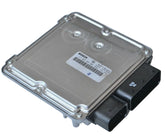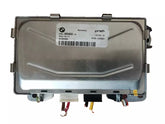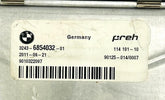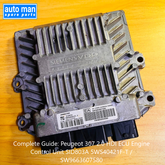زيت المحرك هو شريان الحياة لسيارتك. فهو يحافظ على تزييت أجزاء المحرك، ويقلل الاحتكاك، ويمنع ارتفاع درجة حرارته. فبدون زيت نظيف، قد يتعرض محركك لأضرار جسيمة وانخفاض في أدائه.
في أوتومان لقطع الغيار ، نلتزم بمساعدة مالكي السيارات ليس فقط في العثور على أفضل قطع غيار السيارات الأصلية، بل أيضًا في صيانة سياراتهم بالطريقة الصحيحة. في هذا الدليل، سنشرح لك كيفية تغيير زيت المحرك منزليًا ، وعدد مرات القيام بذلك، وأهميته.
لماذا يعد تغيير زيت المحرك مهمًا؟
يتحلل الزيت طبيعيًا ويتلوث بالأوساخ والكربون والجسيمات الأخرى مع مرور الوقت. وهذا يؤدي إلى:
-
زيادة تآكل المحرك
-
ارتفاع درجة الحرارة
-
كفاءة الوقود ضعيفة
-
تراكم الحمأة في المحرك
-
خطر فشل المحرك بالكامل
تساعدك تغييرات الزيت المنتظمة على تجنب الإصلاحات المكلفة وإطالة عمر سيارتك.
ما هي المدة التي يجب عليك فيها تغيير زيت المحرك؟
يعتمد تكرار تغيير الزيت على طراز سيارتك ونوع الزيت وظروف القيادة :
| نوع الزيت | الفاصل الزمني الموصى به |
|---|---|
| النفط التقليدي | كل 3000 – 5000 ميل (4800 – 8000 كم) أو كل 3 – 6 أشهر |
| زيت صناعي | كل 7,500 – 10,000 ميل (12,000 – 16,000 كم) أو كل 6 – 12 شهرًا |
نصيحة احترافية: راجع دائمًا دليل المالك الخاص بك لمعرفة الفاصل الزمني الدقيق ومواصفات الزيت.
الأدوات والمواد التي ستحتاجها
قبل أن تبدأ، قم بجمع ما يلي:
-
زيت محرك جديد (تحقق من اللزوجة والحجم من دليل المالك الخاص بك)
-
فلتر زيت جديد
-
وعاء تصريف الزيت
-
قمع
-
مفتاح فلتر الزيت
-
مفتاح المقبس (عادةً 13 مم - 17 مم)
-
القفازات والخرق ونظارات السلامة
-
رافعة السيارة وحوامل الرافعة (إذا لزم الأمر)
دليل خطوة بخطوة: كيفية تغيير زيت المحرك
1. قم بتسخين المحرك (5 دقائق)
شغّل سيارتك واترك المحرك يعمل لمدة خمس دقائق تقريبًا. هذا يُسخّن الزيت، مما يُسهّل تصريفه بشكل أسرع وأكثر اكتمالًا أثناء عملية التفريغ.
2. قم بإيقاف السيارة على سطح مستوٍ
أطفئ المحرك، وشغّل فرامل اليد، وتأكد من ثبات سيارتك. عند الحاجة، ارفع السيارة باستخدام رافعة هيدروليكية ، وثبتها بحاملات رافعة لسهولة الوصول إليها من الأسفل.
3. ضع وعاء تصريف الزيت
حدّد مكان سدادة تصريف الزيت أسفل المحرك (عادةً أسفل حوض الزيت). ضع حوض تصريف الزيت أسفلها مباشرةً لتجميع الزيت المُستهلَك.
4. تصريف الزيت القديم
استخدم مفتاح ربط لفكّ سدادة تصريف الزيت وإزالتها . انتبه، سيكون الزيت ساخنًا! اتركه يتصفّى تمامًا في المقلاة (يستغرق ذلك حوالي ٥-١٠ دقائق).
بمجرد الانتهاء من ذلك، قم بتنظيف سدادة التصريف وإعادة تثبيتها بشكل آمن.
5. قم بإزالة فلتر الزيت القديم
استخدم مفتاح فلتر الزيت لإزالة فلتر الزيت (عادةً ما يكون موجودًا بالقرب من وعاء الزيت أو على كتلة المحرك).
قبل تركيب الفلتر الجديد، ضع طبقة رقيقة من الزيت الجديد على الحشية المطاطية الموجودة أعلى الفلتر الجديد.
قم بتركيب الفلتر الجديد يدويًا فقط - لا تقم بإحكامه بشكل مفرط.
6. صب زيت المحرك الجديد
افتح غطاء المحرك وأزل غطاء تعبئة زيت المحرك (عادةً ما يكون مكتوبًا عليه "زيت" أو يحمل رمز علبة زيت).
أدخل قمعًا واسكب الزيت الجديد ببطء . راجع دليل المستخدم لمعرفة الكمية الصحيحة.
بعد التعبئة، افحص مقياس الزيت - امسحه، ثم أعد إدخاله، ثم اسحبه للخارج. تأكد من أن مستوى الزيت ضمن النطاق الآمن (بين الحد الأدنى والحد الأقصى).
7. قم بتشغيل المحرك وتحقق من وجود تسريبات
بمجرد ملء المحرك، قم بتشغيله واتركه يعمل في وضع الخمول لمدة 1-2 دقيقة.
قم بإيقاف تشغيله وفحص الجانب السفلي بحثًا عن أي تسرب للزيت.
بالإضافة إلى ذلك، قم بإعادة التحقق من مستوى الزيت وأعد تعبئته إذا لزم الأمر.
8. تخلص من الزيت القديم بطريقة مسؤولة
زيت المحرك المستعمل خطر. صُبّه في وعاء محكم الإغلاق وانقله إلى مركز إعادة تدوير محلي، أو ورشة سيارات، أو منشأة للتخلص من النفايات الخطرة. لا تصبّه أبدًا في البالوعة أو في سلة المهملات.
علامات تشير إلى أن سيارتك بحاجة إلى تغيير الزيت
-
زيت داكن وقذر على مقياس العمق
-
طرق المحرك أو الأصوات العالية
-
ضوء تحذير الزيت على لوحة القيادة
-
ضعف الاقتصاد في استهلاك الوقود
-
رائحة الزيت المحترق
نصائح نهائية من قطع غيار أوتومان
-
احتفظ دائمًا بفلتر زيت احتياطي وزيت إضافي في المرآب الخاص بك.
-
استخدم مرشحات OEM أو مرشحات ما بعد البيع عالية الجودة لضمان حماية المحرك.
-
إذا لم تكن متأكدًا من مواصفات الزيت، فاتصل بشركة تصنيع سيارتك أو ميكانيكي موثوق به .







